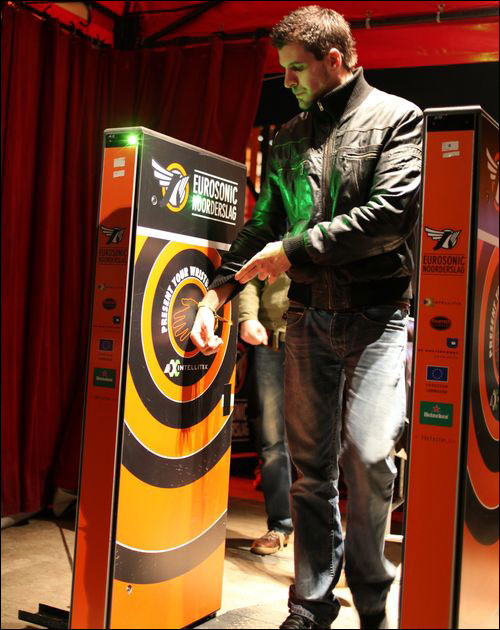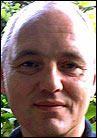When 3,150 music-industry professionals, musicians and their fans converged at Eurosonic Noorderslag, held earlier this month in Holland, the organizers of the three-day music event employed an RFID-based system to track ticket holders’ movements, expedite entry and re-entry, and provide beverages and other special services to some participants. Attendees wore RFID wristbands that were read by fixed portal readers and handheld interrogators at a variety of concert halls, clubs and cafés throughout the city of Groningen. The technology, including wristbands, readers and a hosted server to track location data, were supplied by Intellitix, a provider of RFID access-control and cashless-payment solutions.
The annual Eurosonic Noorderslag festival and conference, first organized in the 1980s as a way to showcase local Dutch and Belgian bands, is Europe’s largest industry event for new music. It draws professionals from around the world seeking to promote bands or manage their own music festivals, as well as hundreds of European musical groups. During the event, bands perform for ticket holders at a variety of venues in the town every evening, while concert promoters, agents and talent scouts participate in meetings, panel discussions and workshops with other music professionals throughout the day.

The program, which has been growing in size, requires considerable planning to manage the movements of crowds through the conferences, as well as at the evening concerts. Many of the concerts take place at the city’s cultural center, De Oosterpoort, and there are multiple entrance points for the venues, at which—until this year—ticket holders had to present paper tickets in order to be visually inspected by staff members. This was not only time-consuming, leading to queues, but also provided the opportunity for fraud due to counterfeit tickets, or if a legitimate ticket holder passed his ticket to someone else outside the venue, allowing an unauthorized person to enter.
Ruud Berends, Eurosonic Noorderslag’s head of international promotion and monitoring, says that during previous years’ events, when he needed to determine the number of visitors at any given location, he had to rely on phoned-in reports from workers at the various sites, which were only estimates of how many people attended each program. With an RFID system, says Greg Parmley, Intellitix’s chief information officer, that information was made available on an Intellitix server, based on RFID wristband reads.Intellitix deployed 18 entrance portals with RFID readers that it manufactures itself. Some were installed at the festival’s entry point, others at specific locations within the conference area, or at concert venues. In addition, Eurosonic Noorderslag’s staff utilized 100 handheld readers, also provided by Intellitix, at other locations, throughout the one-square-kilometer (0.4-square-mile) area.
Each ticket holder arriving at the site was provided with a Dutchband wristband containing a built-in 13.56 MHz passive RFID tag compliant with the ISO 15693 standard. Every ticket holder had the option of having his name and company linked to the wristband’s ID number. Those choosing to opt out remained anonymous, with no name linked to the wristband ID. Of the 3,150 attendees, Berends says, only 192 chose to opt out. Those granted special privileges, such as a specific number of drinks at the concession area, could also link that data to his ID. What’s more, at a select few read points, an individual could have information sent to his e-mail address, by having his tag interrogated at a reader dedicated for that purpose. The visitor would then receive an e-mail listing more information regarding a particular program.
Whenever a ticket holder entered the festival or concert venue, that individual’s wristband was read by RFID readers that captured his ID and forwarded it to Intellitix’s hosted server, where Intellitix software linked that number to the attendee’s personal data and stored the read event, thereby indicating that person had entered. The same process occurred if the visitor left the grounds and then returned.
Upon entering a conference room or panel discussion, an attendee could either walk through an RFID portal or have his wristband read via a handheld interrogator, and that read event was then stored in the software. If the individual had opted out, only that person’s ID number was stored, still indicating that the visitor had entered a specific room or area. A person looking to redeem a drink, for instance, could simply present his wristband at the bar or concession area, where an employee would read the tag, thereby indicating that one drink had been received. That status was then updated in the individual’s electronic records.Intellitix introduced its RFID solution in 2010, at a music festival in Quebec. Last summer, Parmley says, the technology “was a runaway—something that caught us a bit by surprise,” with more installations at music festivals in North America than the company expected. In 2011, the system was deployed at the Austin City Limits Music Festival; the Bonnaroo Music and Arts Festival, in Tennessee; Lollapalooza, in Chicago; and San Francisco’s Outside Lands Music and Arts Festival, to name a few. The technology proved to offer a better method for managing access control, the company reports, enabling ticket holders to pass through RFID portals at a rate of up to 3,000 people per hour, or 1,000 to 1,200 when tags were read using a handheld interrogator. At Bonnaroo, the system was also used to link wristband wearers with their Facebook accounts, enabling them to “like” a band or program to share with friends on that social network.
An attendee could also use his wristband to pay for food or other items, with the purchase deducted from a prepaid account linked to that person’s wristband ID number. That unique ID could also be linked to an individual’s e-mail address, so that every time the visitor had his tag read at a specific location, that read would trigger an e-mail to be sent to that person, containing further information regarding the event underway. For example, if someone enjoyed a particular band’s performance, he could use the wristband to “like” the band on Facebook, receive an e-mail providing additional information about that group, and sign up to be sent future updates.
Berends hopes to take advantage of these features at next year’s event. He envisions that individuals attending a panel discussion could receive more details about that session delivered to their e-mail address (this year, such a function was available only at a few select venues). A visitor could also use the feature to learn more about a specific band. However, Berends adds, Eurosonic Noorderslag has no intention of using RFID data to track attendees and their locations individually at the event.
Berends says he is still analyzing the details of attendees’ movements throughout the 2012 event. In approximately a week, he says, he expects to have a better understanding of crowd movement, and could, if necessary, modify planning for the 2013 event, based on the numbers of visitors at any particular program—for example, to better manage foot traffic from one location to another.


